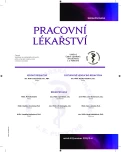Follow-up and evaluation of medical state of employees in selected operations of automobile industry
Authors:
M. Hrušková 1; J. Buchancová 1,2; M. Strýčková 1; J. Zibolenová 2; Š. Zelník 1; H. Hudečková
Authors‘ workplace:
ŽILPO, s. r. o., Žilina, Slovensko
vedúci MUDr. Štefan Zelník, PhD.
1; Ústav verejného zdravotníctva Jesseniovej lekárskej fakulty Martin, Univerzita Komenského Bratislava
vedúca prof. MUDr. Henrieta Hudečková, PhD., MPH
2
Published in:
Pracov. Lék., 67, 2015, No. 3-4, s. 86-91.
Category:
Original Papers
Overview
The problems of hearing impairment from noise in the automobile production industry have not been sufficiently covered in our recent medical literature. The main goal of the investigation was to evaluate hearing disorders in relation to the work at risk performed in excessively noisy environment of two mechanical engineering production plants in Slovakia, where components for assembly are produced and supplied to several automobile production plants. In the group of 195 employees at the age of 37.5 ± 11.7 years (M ± SD), medical preventive entry and follow-up examinations after a certain period of time from the beginning of work in the company were made in the period, when a contractual collaboration of the production plants with the Occupation Medical Service. The determination of medical capability for work, associated with the risk factors (in noise risk the classification into Category III and IV of work art risk) could be established only after the first evaluation of Preventive Medical Examinations, when the actual noise risk in the observed plants could be supplemented with the work at risk in the previous workplaces of the employees.
In the first group of the cohort, 33 employees, men at the age of 44.6 ± 10.6 years produced components of motor vehicles and their engines by welding exhaust pipes for automobile large scale producers. In 9 of them the total hearing loss exceeded 10% according to Fowler and 25.3 ± 17.7 % according to audiometric examination, while exposure to noise in these men combined 23.0 ± 5.3 years of work in noise environment previously and 4.9 ± 2.0 years of exposure to noise at the present workplace.
The second younger group encountered 162 employees (87 men at the age of 35.4 ± 11.0 years and 75 women at the age of 37.31 ± 11.7 years) who had worked in the pressed down cold-forming of metals (category IV of the noise factors), in welding of mould components and in hand-operated spray gun varnishing (category III). In 8 of them (one woman included) total heating loss exceeded 10% according to Fowler and 17.3 ± 7.8%, according to audiometric examination, while noise exposure in this group was a combination of 8.6 ± 7.3 year-long noise exposure before the last workplace and 1.9+1.2 year-long work in noise environment at the last workplace.
In the first (entry) examination of the whole group, not considering the relatively short period of noise exposure at the previous workplaces, 17 cases of hearing impairment with total hearing loss according toe Flower exceeding 10-59%, while four persons of this group were subsequently laid off the noise risk for contraindication to work permanently. The occupational disease from noise was notified in one of them.
The authors draw attention to unavoidable examination of entry medical examinations before starting the employment, with adequate documentation of exposure to the work risk factors in the past. It is of great importance for correct assessment of medical capability for work considering the expected risk factor of working environment also in relation to decreasing health damage of the employees. Last, but not least it represent a benefit for the employers to prevent his liability in the origin of occupational diseases, which may have been dominantly from previous exposures of the work risk factors.
KEYWORDS:
health impairment – audiometry – noise – BMI – smoking – entry and follow-up examinations – preventive medical examinations related to work
Sources
1. Andrejiová M., Piňosová M., Lumnitzer E. Nový prístup k hodnoteniu vplyvu hluku a vibrácií na zdravie zamestnancov v prevádzkach autoservisov. Pracov. Lék., 2013, 65, 3–4, s. 88–99.
2. Baška, T., Katreniaková, Z. Základy prevencie užívania tabaku. Martin: JLF UK 2010, 101 s., ISBN 978-80-88866-89-3.
3. Hrnčíř, E. Hluk z pracovnělékařského hlediska. Pracov. Lék., 2013, 65, 1–2, s. 59–66.
4. http://www.economy.gov.sk.
5. Jílková, L., Machartová, V. Kazuistika pacienta s percepční poruchou sluchu. Pracov. Lék., 2014, 66, 1, s. 40–43.
6. Jurečka, T. Zásady posuzování spůsobilosti k práci při vadách zraku a onemocnění očí. Pracov. Lék., 2005, 57, 1, s. 24–26.
7. Legáth, Ľ. Choroby z povolania v SR z pohľadu klinického pracovného lekárstva. Pracov. Lék., 2010, 62, 4, s. 184–189.
8. Marejková, E., Cisariková, S. Hodnotenie fyzickej záťaže pri práci: finálna inšpekcia – práca na linke. In Hudečková, H., Švihrová, V., Baška, T. Aktuálne problémy verejného zdravotníctva vo výskume a v praxi. Recenzovaný zborník vedeckých a odborných prác I. Martin: JLF UK, 2013, s. 178–190, ISBN 978-80-89544-39-7.
9. Nakládalová, M., Kaproun, S. Zdravotní spůsobilost k práci u osob s diabetem. Pracov. Lék., 2004, 56, 1, s. 13–16.
10. Odborné usmernenie MZ SR o náplni lekárskych preventívnych prehliadok vo vzťahu k práci č. 10525/2010-OL.
11. Piňosová, M., Andrejiová, M., Lumnitzer, E. Analýza klinických príznakov synergie pôsobenia hluku a vibrácií na zdravie človeka v prevádzkach s ich vysokou expozíciou. Pracov. Lék., 2012, 64, 2–3, s. 103–111.
12. Vandasová, Z., Vencálek, O., Dobisík, O. Dvě desetiletí monitorování hluku: Vývoj hluku v městských lokalitách České republiky. Hygiena, 2013, 58, 3, s. 100–105.
Labels
Hygiene and epidemiology Hyperbaric medicine Occupational medicineArticle was published in
Occupational Medicine

2015 Issue 3-4
Most read in this issue
- Infectious and parasitic occupational diseases notified in professional soldiers in the years 2007–2012
- Cytogenetic examination in medical personnel exposed to cytostatic drugs
- Follow-up and evaluation of medical state of employees in selected operations of automobile industry
- Medical problems in the work of nursing staff in multiplace hyperbaric chambers
